Mastering the Art of Rock and Crystal Identification


Intro
Identifying rocks and crystals can be both an art and a science. For enthusiasts and collectors, understanding these elements may greatly enhance their collecting experience. It starts with knowing the characteristics that define rocks and crystals, the classification methods available, and the tools required for exploration. In this article, we will examine these topics and provide practical techniques for both beginners and seasoned collectors.
Featured Collectible of the Month
Overview
This month, our focus will be on the striking Amethyst. This purple quartz variety is often sought after for its beauty and perceived healing properties. It commonly ranges from pale lavender to deep violet and is a popular choice among collectors. Amethyst forms in geodes, hollow rocks lined with mineral crystals, allowing for extraordinary displays of color and clarity.
Historical Significance
Amethyst has been treasured throughout history, recognized by ancient cultures for its supposed protective properties. The Greeks used it as a means of intoxication control, believing it could prevent drunkenness. In the Middle Ages, it was regarded as a stone of royalty, often found in crowns and scepters. Today, its allure endures, captivating collectors who appreciate its unique quality and lore.
Identification Techniques
Identifying rocks and crystals effectively involves several methods. Collectors often rely on visual characteristics, as well as other educational resources.
Visual Characteristics
When attempting to identify a rock or crystal, the following visual attributes are crucial:
- Color: Observe the primary hues and any variations present.
- Luster: Analyze how light interacts with the surface, which can be glossy, matte, or metallic.
- Transparency: Determine whether the specimen is opaque, translucent, or transparent.
- Hardness: Utilize the Mohs scale to assess the scratch resistance of your specimen relative to common materials.
- Crystal Form: Note the shape. Crystals may have distinct geometrical forms that can aid in identification.
Resources for Identification
A variety of tools and resources can assist in the identification process. Helpful items include:
- Hand lens or magnifying glass: To observe fine details.
- Field guides: Books specializing in rocks and minerals.
- Apps: Mobile applications such as Rock Identifier can help streamline the process.
- Online Communities: Platforms like Reddit and Facebook groups dedicated to geology and rock collecting provide valuable advice.
"Understanding the underlying geology of an area can significantly improve your identification skills. Knowing where to look is as important as knowing what to look for."
By consistently utilizing these techniques and resources, collectors can deepen their understanding of rocks and crystals, ensuring a well-rounded and informed collecting experience.
Prolusion to Rock and Crystal Identification
Identifying rocks and crystals is more than just a hobby; it is a profound exploration into the Earth's geological history and physical beauty. This section sets the foundation for understanding the various properties and classification methods essential for accurate identification. Knowledge in this area opens a pathway to not only appreciate the diverse forms of minerals but also to comprehend their significance in various ecosystems and human usage.
Importance of Proper Identification
Proper identification of rocks and crystals is a critical skill for collectors and enthusiasts alike. It allows individuals to understand the origin, characteristics, and potential applications of the materials in their collection. Misidentification can lead to misconceptions about a specimen's authenticity and value.
In geological studies and earth sciences, accurate identification is crucial for research and educational purposes. It aids in environmental assessments and helps to inform sustainable practices in mineral extraction. Therefore, the urge to identify should be driven by a keen sense of curiosity and responsibility, acknowledging the implications of our findings.
A Brief Overview of Types of Rocks and Crystals
Rocks and crystals are classified broadly into three categories: igneous, sedimentary, and metamorphic rocks. Each category reflects distinct processes of formation.
- Igneous Rocks originate from cooled and solidified magma or lava. Examples include granite and basalt.
- Sedimentary Rocks form from the accumulation of mineral and organic particles. Sandstone and limestone are common types.
- Metamorphic Rocks arise from existing rocks that undergo transformation due to high pressure or temperature, such as marble from limestone.
Crystals, on the other hand, are solid materials whose constituents are arranged in a lattice structure. Their properties vary significantly, with some common types being quartz, calcite, and fluorite. Understanding these classifications is fundamental for identifying and appreciating the existing diversity. By grasping these concepts, readers can develop a more intricate understanding of the world beneath our feet.
Understanding Geological Basics
Understanding geological basics is fundamental for anyone interested in identifying rocks and crystals. Knowledge in this area lays the foundation for all further explorations and observations. It allows enthusiasts and collectors to grasp the natural processes that shape geological materials, ultimately aiding in accurate identification.
Mineral Composition
Mineral composition is the key factor in identifying rocks and crystals. Each mineral has a unique chemical formula and physical properties. When collectors examine a specimen, recognizing its mineral constituents helps in accurately identifying both rock types and crystals.
For instance, quartz is composed of silicon dioxide (SiO2) and its presence indicates that the rock may have originated from igneous, sedimentary, or metamorphic processes. Furthermore, understanding mineral composition enables collectors to appreciate the relationship between minerals and their environments of formation.
Key Points to Remember:
- Unique chemical structures define different minerals.
- Rocks can consist of one or more minerals.
- Proper identification begins with analyzing mineral composition.
Rock Cycle Fundamentals
The rock cycle describes how rocks change from one type to another over geological time. This knowledge is crucial for collectors, as it explains the origins and transformations of rocks. Understanding the rock cycle ensures a more informed approach to identification through various contexts and environments.
This cycle involves three main categories of rocks:
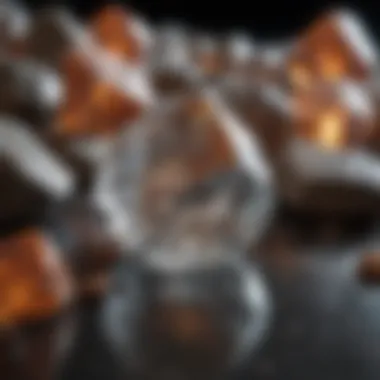
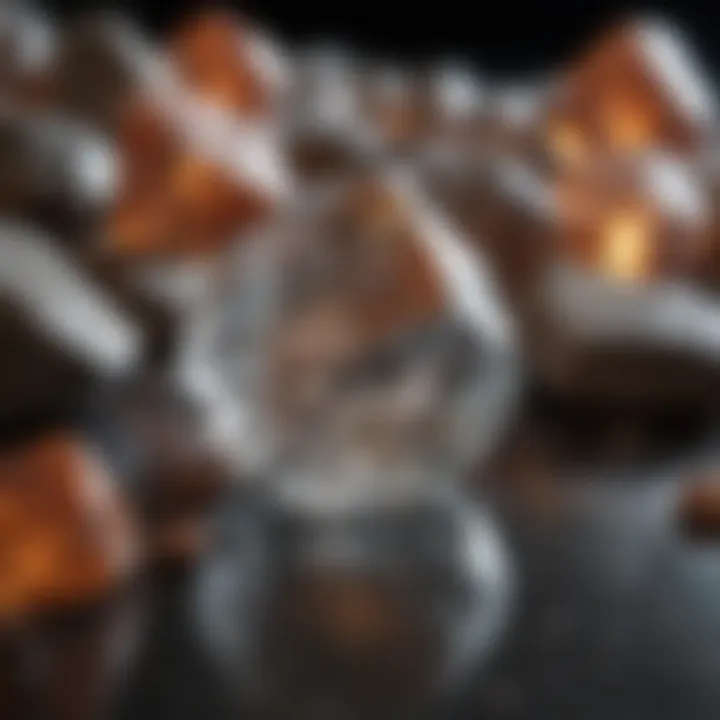
- Igneous: Formed from the cooling and solidification of magma or lava.
- Sedimentary: Created by the accumulation of sediments compressed over time.
- Metamorphic: Resulting from the alteration of existing rocks due to heat, pressure, or chemically active fluids.
Each type carries distinct properties and clues that aid in their identification.
Crystal Formation Processes
Crystal formation processes are integral to understanding how minerals crystallize and grow within rocks. This knowledge provides insight into the conditions under which a crystal formed, which often correlates with its specific properties.
Crystals can form through various methods, including:
- Cooling of magma: Slow cooling allows larger crystal formation, such as in granite.
- Evaporation: Crystals like halite form as water evaporates and leaves minerals behind.
- Metamorphism: High pressure and temperature can lead to the growth of new crystals within existing rock.
By grasping these processes, collectors gain valuable context for their specimens, which helps discern their origins and characteristics.
Essential Tools for Identification
Identifying rocks and crystals requires a set of tools that enhances observation and analysis. Without the right equipment, one might overlook essential characteristics that distinguish one mineral from another. Each tool serves a specific purpose, whether it is for observing minute details, conducting tests on physical properties, or gathering field data. Thus, having the essential tools at hand not only simplifies the identification process but also increases the accuracy of one’s assessments.
Basic Equipment for Collectors
Basic equipment helps beginners and casual collectors in their identification journey. Here are some common items:
- Rock Pick: This tool is critical for field collection. A good rock pick allows collectors to break apart larger stones and access the minerals within.
- Hand Lens: A hand lens or loupe provides a closer view of a rock's surface. This aids in examining fine details, such as crystal structure and surface texture.
- Field Guide: An excellent field guide helps in preliminary identification. Comprehensive guides often include pictures and descriptions of rocks and minerals.
- Sturdy Backpack: Carrying tools in a proper bag ensures that everything remains organized and safe during exploration.
- Notebook and Pen: Documenting findings is essential. A notebook can record observations, locations, and any unique features.
These basic tools provide a solid foundation for rock and crystal identification. By using them, collectors can recognize and appreciate different specimens with greater ease.
Advanced Tools for Detailed Analysis
For more serious enthusiasts or those engaged in professional geological study, advanced tools become necessary to achieve precise results. Here are some tools for deeper analysis:
- Hygrometer: Essential for measuring humidity, which can affect the stability of certain minerals. This is particularly useful when maintaining a collection.
- Hardness Testing Kit: Such kits allow for testing a rock or crystal’s hardness using the Mohs scale. Ensuring accurate hardness measurements is vital for identification.
- Polariscope: This instrument helps in studying the optical properties of minerals. It is beneficial for distinguishing between different types of crystals based on their birefringence.
- X-ray Fluorescence (XRF) Analyzer: This is a powerful tool for determining the elemental composition of minerals. While it may be costly, it yields reliable data for serious collectors or researchers.
- Geological Hammer: Unlike a standard rock pick, a geological hammer is designed with one side for splitting rock and another side for chiseling. This versatility makes it a preferred choice for larger specimens.
Advanced tools support an in-depth understanding of the mineralogical context and characteristics. They equip users to conduct analyses that go beyond mere visual inspection, providing insights into composition and properties that can be critical for scientific study or detailed classification.
"The right tools are essential not only for collecting but also for understanding the intricate details of rocks and crystals."
Utilizing both basic and advanced identification tools enhances the collector's ability to appreciate the complexity and beauty of their finds.
Identification Techniques
Identifying rocks and crystals requires a blend of observational skills and knowledge of geological features. This section delves into various identification techniques and their importance in accurately classifying different specimens. A robust approach to identification allows collectors to deepen their understanding of the minerals and rocks they encounter. Each technique offers unique insights, making it vital for anyone interested in geology to adopt and adapt them.
Visual Inspection Methods
Visual inspection is often the first step in identifying rocks and crystals. It involves careful observation of a specimen's surface, color, and overall appearance. The goal is to gather initial impressions that guide further investigation.
When conducting visual inspections, lighting conditions are crucial. Natural light often provides the best point of reference, revealing true color and luster. Additionally, varying angles of view can uncover unique textures and patterns that are not immediately apparent.
Physical Properties to Observe
Each rock or crystal showcases distinct physical properties. A thorough examination of these properties serves as a reliable method for identification.
Color
Color is one of the most obvious characteristics to notice. It can be indicative of the mineral composition present within the specimen. For example, quartz appears in various hues, from clear to smoky gray. However, color alone can sometimes be misleading due to the effects of weathering or environmental factors. Therefore, while color is a beneficial first step, it is crucial to consider it in conjunction with other properties.
Luster
Luster refers to how light interacts with a mineral's surface. It can be categorized into several types, such as metallic, pearly, or vitreous. Observing luster provides valuable clues to a mineral's identity. A specimen with a glassy luster can often indicate the presence of quartz or similar minerals. Its unique feature is its reflection of light, which varies widely among different minerals. Thus, understanding luster aids in narrowing down identification.
Hardness
Hardness is a key property based on the Mohs scale, which ranks minerals from 1 (talc) to 10 (diamond). The hardness of a specimen allows collectors to assess its durability and potential applications. For example, calcite has a hardness of 3, making it relatively soft and easy to scratch. Recognizing the hardness contributes significantly to confirming identification as certain minerals possess definitive hardness levels.
Cleavage
Cleavage describes how a mineral breaks along specific planes of weakness. Some minerals, like mica, exhibit perfect cleavage, while others do not show any clear pattern. Understanding cleavage is important for identification because it can often exclude several options based on how the specimen breaks. This characteristic helps discern between similar-looking minerals, enhancing the precision of identification.
Fracture
Fracture occurs when a mineral breaks irregularly, without a plane of cleavage. Identifying fracture patterns, such as conchoidal (smooth curves) or fibrous, adds another layer of understanding about the specimen. Fracture complements the assessment of cleavage, assisting collectors in making accurate identifications. This technique becomes particularly useful when cleavage is not evident or absent altogether.
Using a Hand Lens
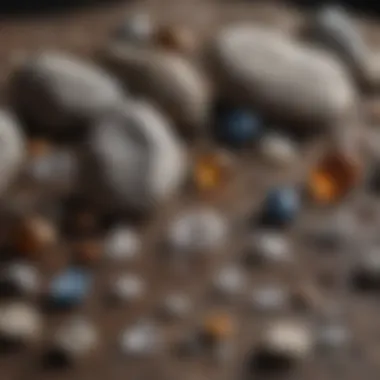

Employing a hand lens can significantly enhance the identification process. A simple magnifying lens allows for detailed examination of smaller features. Collectors can observe growth patterns, inclusions, and any minute details that are invisible to the naked eye. Using a hand lens improves the accuracy of identification methods and provides a deeper appreciation for the specimen's complexity. It is an indispensable tool for any serious rock or crystal collector, making it easier to discern between closely related species.
Utilizing Reference Materials
Reference materials are crucial tools for anyone looking to identify rocks and crystals effectively. They provide a structured approach to understanding the complexities of geological formations. By using these resources, both novices and experienced collectors can gain insights that enhance their identification skills.
Field Guides and Identification Manuals
Field guides and identification manuals serve as primary references for rock and crystal identification. They typically offer detailed descriptions of various minerals and rocks, including their physical characteristics, habitats, and formation processes. The benefits of utilizing these manuals include:
- Visual Aids: Many field guides include photographs and illustrations that help users recognize specific features in the field.
- Quick Reference: Compact and portable, they can easily accompany collectors during field trips.
- Local Context: Many manuals focus on specific regions, providing more relevant information based on local geology.
When choosing a field guide, it is essential to consider its credibility and scope. Some popular options among collectors include the "Peterson Field Guide to Rocks and Minerals" and "The National Audubon Society Field Guide to North American Rocks and Minerals". These resources facilitate a deeper understanding of how to categorize and identify various specimens.
Online Resources and Databases
With the rise of technology, online resources and databases have emerged as valuable assets for rock and crystal identification. The advantages of utilizing these platforms include:
- Accessibility: Websites like Wikipedia or Britannica provide extensive information that can be accessed at any time.
- Up-to-date Information: Online databases often include recent discoveries or shifts in classification that might not be available in print manuals.
- Community Engagement: Platforms like Reddit or Facebook enable collectors to share experiences, ask questions, and gain insights from a larger community.
For instance, utilizing online databases, such as the Mindat.org, can provide in-depth mineral data along with geolocations. Additionally, instructional videos or courses available on platforms like YouTube can enhance practical skills through visual demonstrations.
Using reference materials effectively requires one's commitment to continuous learning. They not only aid in identification but also deepen one's appreciation of geology as a discipline. In this way, reference materials are more than tools; they are gateways to enhance knowledge in rock and crystal identification.
Chemical and Advanced Analytical Methods
Chemical and advanced analytical methods play a crucial role in identifying rocks and crystals. These techniques provide a deeper understanding of the materials at a molecular level. This section will underline the significance of chemical compositions and introduce advanced analysis methods like X-ray diffraction. Knowledge in these areas is vital for both amateur collectors and professional geologists.
Importance of Chemical Compositions
Chemical composition refers to the specific elements that make up a rock or crystal. Every mineral has a unique composition, which can determine its properties and behavior. Understanding the chemical makeup is essential because it helps in the classification of rocks and minerals. For example, quartz (SiO₂), feldspar (KAlSi₃O₈), and calcite (CaCO₃) are all distinct in their composition.
Moreover, chemical analysis can reveal information about the formation conditions of a mineral. For instance, certain elements may only be present in specific environments, offering clues about where and how a mineral was formed. It's important for collectors to recognize these aspects. If they can discern between similar-looking minerals through their chemical traits, such as the presence of iron or magnesium, they can identify the specimen more accurately.
X-ray Diffraction and its Application
X-ray diffraction is a powerful technique used for identifying the crystalline structure of minerals. This method involves directing X-ray beams at a sample and measuring the angles and intensities of the resulting scattered beams. The patterns generated help in determining the arrangement of atoms within the crystal structure.
This technique is particularly useful when distinguishing between minerals that may appear similar visually. For instance, both calcite and aragonite are calcium carbonate minerals but have different crystal structures. Analyzing them through X-ray diffraction can confirm their identity.
Some benefits of using X-ray diffraction include:
- Precision: It provides accurate data on the crystal structure.
- Versatility: It can analyze various samples, from small powders to larger specimens.
- Non-destructive: The analysis typically does not alter the sample.
However, the use of X-ray diffraction comes with considerations. It requires specialized equipment and expertise, which may not be available to all rock and mineral enthusiasts. Despite this, understanding these analytical methods enhances the identification skills of collectors striving for precision in their collections.
"Understanding the chemical and crystallographic properties of minerals enriches our connection to the earth's history and diversity."
In summary, embracing chemical and advanced analytical methods is essential for anyone serious about identifying rocks and crystals. These techniques can unlock the hidden secrets of mineral composition, aiding in more accurate identification and appreciation.
Common Rocks and Their Characteristics
Understanding common rocks and their characteristics holds significant value in the broader context of rock and crystal identification. Each rock type provides insight into geological processes and environmental conditions that shaped them. Recognizing these features aids in classification and enhances the collector’s knowledge, ultimately leading to better appreciation of geological diversity.
Igneous Rocks
Igneous rocks are formed from the cooling and solidification of molten material, known as magma or lava. There are two primary categories: intrusive (or plutonic) rocks and extrusive (or volcanic) rocks.
- Intrusive Igneous Rocks: These rocks, like granite, form when magma cools slowly beneath the Earth's surface, resulting in coarse-grained textures. The minerals can often be seen with the naked eye.
- Extrusive Igneous Rocks: Rocks such as basalt form when lava cools quickly on the surface, leading to fine-grained textures where individual minerals are not easily distinguishable.
Identifying igneous rocks involves observing color, texture, and mineral composition. The presence of quartz, feldspar, and mica are key indicators in many igneous types. Additionally, understanding the cooling history provides context about the environment where these rocks formed.
Sedimentary Rocks
Sedimentary rocks are characterized by their formation through the accumulation of sediments. These sediments can be fragments of other rocks, organic materials, or chemical precipitates. Sedimentary processes can reveal a lot about past environments.
- Clastic Sedimentary Rocks: These include sandstone and shale, formed from fragments of other rocks. Their grain size and sorting give clues about the transport method.
- Chemical Sedimentary Rocks: Rocks like limestone are formed from mineral precipitation. Observing mineral interactions and fossil content can clarify their formation process.
Collectors should pay attention to the layering often seen in sedimentary rocks, as well as the presence of fossils, which can indicate specific depositional environments. Notably, recognizing sedimentary structures such as ripple marks or mud cracks is crucial for accurate classification.
Metamorphic Rocks
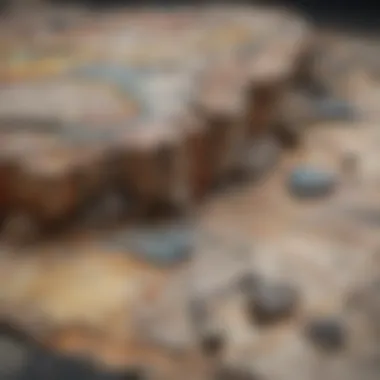
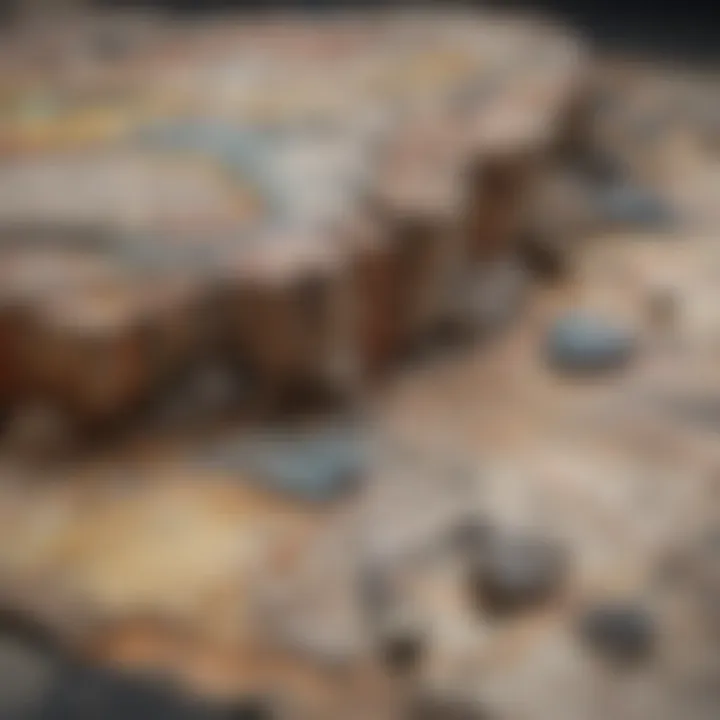
Metamorphic rocks arise from the transformation of existing rock types due to heat, pressure, and chemically active fluids. This process alters the rock's mineral composition and structure, leading to distinct features that aid identification.
- Foliated Metamorphic Rocks: These include schist and gneiss, featuring a banded or layered appearance due to the alignment of mineral grains under directed pressure.
- Non-foliated Metamorphic Rocks: Examples such as marble and quartzite do not display layering and are typically formed through relatively uniform pressure and temperature conditions.
Identifying metamorphic rocks requires keen observation of texture and foliation patterns. The mineral hardness and reaction to acids may also assist in distinguishing between various types. Additionally, the parent rock type can provide context on its formation and classify the metamorphic variety accurately.
Thorough knowledge of rock types greatly enhances understanding of earth processes, enabling precise identification and appreciation.
By recognizing distinct characteristics of igneous, sedimentary, and metamorphic rocks, collectors can make informed decisions and deepen their understanding of geological history. This analytical approach invites a richer connection to the natural world.
Famous Crystals and Their Properties
Understanding famous crystals and their unique properties is essential for any rock and mineral enthusiast. These crystals not only showcase natural beauty, but they also play significant roles in various fields such as geology, jewelry making, and even healing practices. Knowing how to identify these crystals enhances one’s appreciation and provides insight into their formation processes and cultural significance.
Quartz Varieties
Quartz is one of the most abundant minerals found in the Earth's crust, making it a staple in both the geological and jewelry communities. Within the quartz family, there are several notable varieties, each distinguished by its unique characteristics and uses.
- Clear Quartz: Known for its clarity, this variety is often used in electronics and watches due to its piezoelectric properties.
- Amethyst: A popular purple variant of quartz, often linked to tranquility and spiritual growth. Its color results from iron impurities.
- Citrine: This yellow to brown variety is prized for its warmth and is commonly associated with wealth and abundance.
Each of these quartz varieties has distinct optical properties, such as luster and hardness, which help in their identification. For example, the color zoning in amethyst can be observed under a hand lens, making it visually distinct from clear quartz.
Minerals Like Calcite and Fluorite
Calcite and fluorite are two group of minerals that frequently appear in gemstone collections and geological studies. Both offer a range of colors and forms, making them popular among collectors.
- Calcite: A carbonate mineral, calcite can appear in hues from clear to white, yellow, or pink. It has a characteristic rhombohedral cleavage, which can assist in identification. Calcite is essential in cement production and is studied for its geological implications.
- Fluorite: Often referred to as "the most colorful mineral in the world," fluorite can be found in various colors, including purple, green, and blue. Its cubic crystal system simplifies identification, alongside its vitreous luster.
Both calcite and fluorite teach collectors about mineral formation and geological history. Their varying characteristics, like hardness on the Mohs scale, can be crucial when assessing their identity in the field.
Knowing the properties of famous crystals like quartz, calcite, and fluorite enriches one’s understanding of the earth’s geological processes.
The study of these minerals not only enlightens enthusiasts about their physical properties but also highlights their practical applications and cultural significance, thus fostering a deeper appreciation for the natural world.
Practical Identification Activities
Practical identification activities are crucial in the field of rock and crystal identification. Engaging in hands-on experiences allows enthusiasts to apply their theoretical knowledge in real-world settings. Such activities not only cement learning but also foster a deeper appreciation for the diversity found within geological specimens.
Through practical activities, collectors can sharpen their observational skills. This skill is essential for identifying various rock types and crystal structures. Getting outside, collecting specimens, and comparing them with reference materials enriches the educational process. Moreover, these activities help in developing critical thinking as one evaluates the distinguishing features of each specimen.
Field Trips and Collecting Practices
Field trips are often considered the backbone of hands-on learning in geology. They provide the chance to explore diverse geological environments, allowing collectors to study rocks and crystals in their natural settings. Preparing for a successful field trip involves understanding local geology. Researching locations known for specific rock formations or crystal deposits can greatly enhance the collecting experience.
On-field practices should consider the following:
- Safety First: Always plan for safety by bringing appropriate gear, including gloves, helmets, and sturdy footwear.
- Ethics of Collecting: Respect nature by minimizing disturbance and avoiding over-collecting in sensitive areas. Follow local regulations regarding rock and mineral collection.
- Proper Tools: Having the right tools, such as a geological hammer and a field notebook, is essential. A field notebook helps document the location, environment, and characteristics of collected specimens.
Collecting practices can also include photographing locations and specimens. This documentation serves as a valuable resource for later identification and analysis. Fieldwork provides an unparalleled opportunity to connect with geology in a tangible way.
Organizing a Personal Collection
Once collectors have gathered their specimens, organizing a personal collection becomes the next pivotal step. A well-organized collection not only facilitates easy access but also enhances appreciation for the materials collected.
Start by categorizing specimens based on relevant criteria:
- Rock Type: Group rocks into igneous, sedimentary, and metamorphic categories.
- Crystal Classification: Organize crystals by mineral group or color traits.
- Geographical Location: Keeping track of where each specimen originated adds a personal and educational layer to your collection.
Storing specimens properly is also important. Use labeled containers or display cases to protect your collection from damage. Regularly review and update the organization to reflect new acquisitions or additional information learned through research.
Regular maintenance of your collection can foster ongoing learning and engagement with the subject.
By taking part in practical identification activities, collectors not only refine their skills but also contribute to a greater understanding of geological diversity. These experiences deepen the connection to the broader field of geology and enhance the joy of being a rock and crystal enthusiast.
Epilogue
The conclusion of this article on identifying rocks and crystals encapsulates the significance of understanding the various techniques and methods discussed. It is not just a summary but a reflection on how these skills empower collectors and enthusiasts to explore the vast world of geology with confidence.
Recap of Key Identification Techniques
To effectively identify rocks and crystals, one must revisit the key techniques covered. First, visual inspection plays a crucial role; this involves observing the color, luster, and texture of the specimen. Next, understanding physical properties, such as hardness and cleavage patterns, helps distinguish between similar-looking minerals. Using tools like a hand lens allows for a closer examination of crystal structure and inclusions, further aiding in accurate identification.
Lastly, consultative methods such as using field guides and online resources provide essential support for ongoing identification efforts. It is this systematic approach that builds a solid foundation in geological knowledge, making identification a less daunting task.
Encouragement for Continuous Learning
The pursuit of knowledge about rocks and crystals is ongoing. No collector should feel they have reached a limit at any stage. Engaging with communities online and offline, such as forums on Reddit or educational groups on Facebook, enables collectors to gain insights from one another.
Consider attending workshops or local rock shows. These events not only provide hands-on experience but also enrich one’s network with fellow geology enthusiasts. By maintaining a mindset of curiosity and openness to new information, collectors can deepen their understanding and appreciation of these natural wonders. The world of geology is vast and continuing learning is essential for mastering the art of identification.



